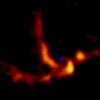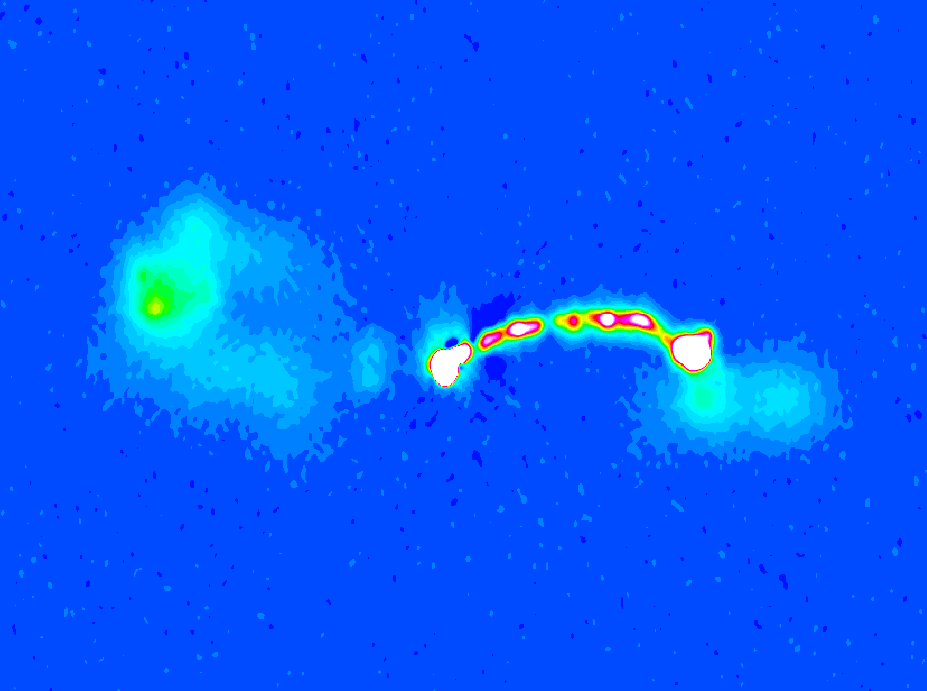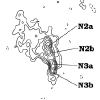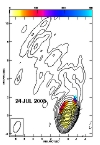| AGNs: Observation | ||||||||||||||||
|
Abstract Using JVLA data of Sgr A* and NRAO 530 (as a calibrator) at 5.5, 9 and 33 GHz, we developed a procedure for the reduction of wideband data. We have demonstrated that, correcting for residual interferometer errors such as residual delays, astronomers can now achieve high-fidelity radio images with a dynamic range exceeding 1,000,000:1. We outline the detailed procedure, noting that it can have broad application to the analysis of broadband continuum observations. We apply this procedure to observations of a distant blazar, NRAO 530, revealing its structures in unprecedented detail. Our 5.5-GHz image shows that the structure of NRAO 530 is prominently characterized by a moderately curved western jet terminating at a hot spot. Close to the radio core, an abrupt bending of the jet is revealed in the high-resolution (<100 mas) images at 33 GHz, showing an evolution of the position angle of the jet from the north at the VLBI scale (50 mas, or ~400 pc projected), increasing toward the west at the larger VLA scales (1 arcsec, or ~10 kpc). The continuation of the jet axis drift forms the curved western jet extending out to 20 arcsec. In contrast, a faint and broad counter-jet is present on the eastern side with a curvature antisymmetric to the western jet. The eastern jet terminates at a bright hotspot, forming an edge-brightened diffuse lobe. The observed contrast in brightness between the western and eastern jets suggests that the jets on the VLA scale are mildly relativistic. The radiation from the western jet is boosted while the radiation from the receding eastern jet is plausibly suppressed owing to the relativistic Doppler effect.
Abstract Using JVLA data obtained from A-array observations of Sgr A* and NRAO 530 (as a calibrator), we developed a procedure for the reduction of broadband data at high-angular resolution. We have demonstrated that, correcting for the residual interferometer errors, such as antenna-based errors in residual delays as well as baseline-based errors in closures,radio astronomers can now achieve high-fidelity radio images with a mega dynamic range (peak:rms) exceeding 1,000,000:1, revealing unprecedented detail in the radio structures surrounding the core of NRAO 530, a distant blazar. Our JVLA broadband image shows that the kiloparsec radio structure of NRAO 530 is prominently characterized by a moderately curved jet terminating at a hot spot extending into a diffuse radio lobe or plume, which is located west of the core. In contrast to the main radio structure, a faint and broad counter-jet is present on the eastern side, feeding into a bigger diffuse lobe, terminated by a brighter spot. The observed morphology of FR I/FR II jets appears to fit NRAO 530 into the class of hybrid blazars. The deep JVLA image provides a different but unique perspective on the close interplay between the central SMBH at the blazar center and its host galaxy. Mega dynamic-range imaging in the era of the ngVLA will shed a light on our understanding of how SMBHs power their jets as well as how they feed back to their host galaxy medium.
Abstract We present multi-frequency radio observational results of the quasar 3C 48. The observations were carried out with the Very Large Array (VLA) at five frequencies, 0.33, 1.5, 4.8, 8.4, and 22.5 GHz, and with the Multi-Element Radio Linked Interferometer Network (MERLIN) at the two frequencies of 1.6 and 5 GHz. The source shows a one-sided jet to the north within 1", which then extends to the northeast and becomes diffuse. Two bright components (N2 and N3), containing most of the flux density, are present in the northern jet. The spectral index of the two components is alphaN2 ~ -0.99+/-0.12 and alphaN3~-0.84+/-0.23 (S~freqalpha). Our images show the presence of an extended structure surrounding component N2, suggestive of strong interaction between the jet and the interstellar medium (ISM) of the host galaxy. A steep-spectrum component, labelled S, located 0.25" southwest to the flat-spectrum component which could be the core of 3C 48, is detected at a significance of >15sigma. Both the location and the steepness of the spectrum of component S suggest the presence of a counter-jet in 3C 48.
Abstract 1156+295 is a flat-spectrum quasar which is loud at radio and gamma-ray. Previous observations of the source revealed a radio morphology on pc to kpc scales consistent with a helical jet model. In our present research, this source was observed with the VLBA at 86, 43 and 15 GHz at four epochs from 10 May 2003 to 13 March 2005 aiming at studying the structure of the innermost jet in order to understand the relation between the helical structure and the astrophysical processes in the central engine. A core-jet structure with six jet components is identified. The apparent transverse velocities of the six jet components derived from proper motion measurements are in the range between 3.6 c and 11.6 c. The overall jet shape shows oscillatory morphology with multiple curvatures on pc scales which might be indicative of a helical pattern. Models of helical jet are discussed on the basis of both Kelvin-Helmholtz (K-H) instability and jet precession. The K-H instability model shows better agreement with the observed data. The overall radio structure on the scale from sub-pc to kpc appears to be fitted with a hydrodynamic model with the fundamental helical mode in Kelvin-Helmholtz (K-H) instability. This helical mode with an initial characteristic wavelength of 0.2 pc is excited at the base of the jet on the scale of 0.005 pc (or 1000Rs, the typical size of the broad line region for a super massive black hole of 4.3x108 Mo). A presessing jet model can also fit the observed jet structure on the scale between 10 pc and 300 pc. However, additional astrophysical processes may be required for the presessing jet model in order to explain the bendings on the inner jet structure (1 to 10 pc) and re-collimation of the large scale jet outflow (>300 pc).
| ||||||||||||||||









